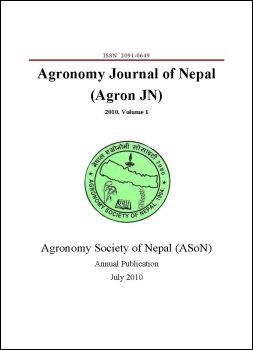Heterosis and yield potentialities of promising maize hybrids suitable for Terai and inner Terai environments of Nepal
DOI:
https://doi.org/10.3126/ajn.v1i0.7544Keywords:
Single cross, top cross, heterosis, economic seed production, commercializationAbstract
Heterosis has made a dramatic impact on the developing of breeding methods and high yields in many field crops during the 20th century. In general, heterosis is greatest in cross pollinated compared to self pollinated crops and thus widely exploited for hybrid cultivar development. Standard heterosis is one of the most important parameters in commercialization of maize hybrids. A new hybrid must be superior to the standard hybrids in terms of grain yield and other economic traits. We have analyzed four coordinated varietal trials of hybrids, 3 of which were conducted at NMRP, Rampur and another was tested at NMRP, Rampur and at ARS, Belachapi, Janakpur from 2006 to 2008 in order to determine the standard heterosis of the promising hybrids. The objective of this study was to evaluate hybrids under different production domains and to select superior hybrids for commercialization. Standard heterosis was calculated based on the best check hybrids and Indian commercial hybrids. The hybrids showed significant differences for grain yields and days to silking in all the trials. Standard heterosis of the tested hybrids ranged from - 39.4 to 47.8%. Most of the hybrids showed positive standard heterosis for grain yield. Hybrids namely; RML- 4/NML-2, RML-6/RML-8, NML-1/RML-8 in 2006 and RML-57/RL-174, NML-1/RML-6 and RL-197/NML-2 in 2008 had more than15% standard heterosis for grain yield evaluated at NMRP, Rampur. Hybrid between RML- 4/NML-2 had only shown positive standard heterosis in 2007 at NMRP, Rampur. RML-4/NML-2, NML-1/RL-17 and RL-111/RL-189 were superior hybrids, which had >15% standard heterosis across NMRP, Rampur and at ARS, Belachapi, Janakpur in 2008. Seed production aspect of these selected hybrids should be studied to develop a complete package of practices for F1 hybrid seed production.
DOI: http://dx.doi.org/10.3126/ajn.v1i0.7544
Agronomy Journal of Nepal (Agron JN) Vol. 1: 2010 pp.67-73
Downloads
Downloads
Published
How to Cite
Issue
Section
License
ASON permits for free use, distribution and reproduction in any medium if the original work is properly cited and not used for commercial purposes.




